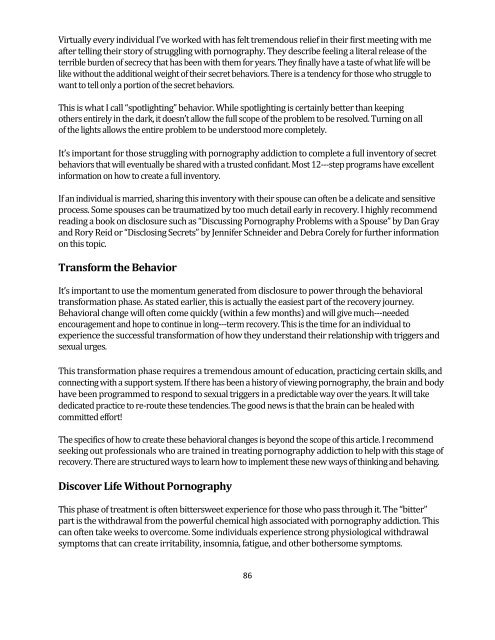Safety Net
Safety Net
Safety Net
You also want an ePaper? Increase the reach of your titles
YUMPU automatically turns print PDFs into web optimized ePapers that Google loves.
Virtually every individual I’ve worked with has felt tremendous relief in their first meeting with me<br />
after telling their story of struggling with pornography. They describe feeling a literal release of the<br />
terrible burden of secrecy that has been with them for years. They finally have a taste of what life will be<br />
like without the additional weight of their secret behaviors. There is a tendency for those who struggle to<br />
want to tell only a portion of the secret behaviors.<br />
This is what I call “spotlighting” behavior. While spotlighting is certainly better than keeping<br />
others entirely in the dark, it doesn’t allow the full scope of the problem to be resolved. Turning on all<br />
of the lights allows the entire problem to be understood more completely.<br />
It’s important for those struggling with pornography addiction to complete a full inventory of secret<br />
behaviors that will eventually be shared with a trusted confidant. Most 12-step programs have excellent<br />
information on how to create a full inventory.<br />
If an individual is married, sharing this inventory with their spouse can often be a delicate and sensitive<br />
process. Some spouses can be traumatized by too much detail early in recovery. I highly recommend<br />
reading a book on disclosure such as “Discussing Pornography Problems with a Spouse” by Dan Gray<br />
and Rory Reid or “Disclosing Secrets” by Jennifer Schneider and Debra Corely for further information<br />
on this topic.<br />
Transform the Behavior<br />
It’s important to use the momentum generated from disclosure to power through the behavioral<br />
transformation phase. As stated earlier, this is actually the easiest part of the recovery journey.<br />
Behavioral change will often come quickly (within a few months) and will give much-needed<br />
encouragement and hope to continue in long-term recovery. This is the time for an individual to<br />
experience the successful transformation of how they understand their relationship with triggers and<br />
sexual urges.<br />
This transformation phase requires a tremendous amount of education, practicing certain skills, and<br />
connecting with a support system. If there has been a history of viewing pornography, the brain and body<br />
have been programmed to respond to sexual triggers in a predictable way over the years. It will take<br />
dedicated practice to re-route these tendencies. The good news is that the brain can be healed with<br />
committed effort!<br />
The specifics of how to create these behavioral changes is beyond the scope of this article. I recommend<br />
seeking out professionals who are trained in treating pornography addiction to help with this stage of<br />
recovery. There are structured ways to learn how to implement these new ways of thinking and behaving.<br />
Discover Life Without Pornography<br />
This phase of treatment is often bittersweet experience for those who pass through it. The “bitter”<br />
part is the withdrawal from the powerful chemical high associated with pornography addiction. This<br />
can often take weeks to overcome. Some individuals experience strong physiological withdrawal<br />
symptoms that can create irritability, insomnia, fatigue, and other bothersome symptoms.<br />
86


